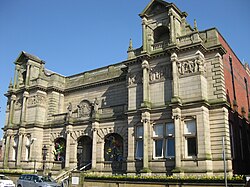| Parish Church of St Mary the Virgin, Bury | |
|---|---|
 Parish Church of St Mary the Virgin, Bury | |
| 53°35′38″N2°17′50″W / 53.5940°N 2.2971°W | |
| OS grid reference | SD 80433 10863 |
| Location | The Rock, Bury, Greater Manchester |
| Country | England |
| Denomination | Anglican |
| Website | Bury Parish Church |
| History | |
| Status | Parish church |
| Founded | 971 CE |
| Dedication | Virgin Mary |
| Consecrated | Candlemas 1876 |
| Architecture | |
| Functional status | Active |
| Heritage designation | Grade I |
| Designated | 13 July 2006 |
| Architect(s) | J. S. Crowther (1870 rebuild) |
| Architectural type | Church |
| Completed | 1876 |
| Specifications | |
| Length | 141 feet (43.0 m) |
| Nave width | 30 feet (9.1 m) |
| Height | 76 feet (23.2 m) |
| Materials | Dressed stone exterior partially lined in brick Slate roof |
| Bells | Eight |
| Administration | |
| Province | York |
| Diocese | Manchester |
| Archdeaconry | Bolton |
| Deanery | Bury |
| Clergy | |
| Rector | Revd. Julian Heaton |
| Curate(s) | Sheila Beattie; Craig Giles. |
| Laity | |
| Director of music | Marc Murray |
| Organist | Elin Rees |
The Parish Church of St Mary the Virgin is located at the highest point in the town centre of Bury, Greater Manchester, England. It is situated on the edge of the town centre. The main body of the church was completed on 2 February 1876, the steeple predates it to 1842. It is designated in the National Heritage List for England as a Grade I listed building. [1]



